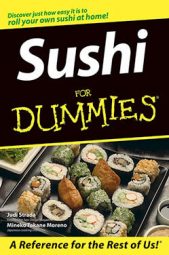How to read the menu at a sushi bar
When you go out for sushi, the number and variety of dishes on the menu can be overwhelming. To help you out, the following lists contain Japanese words and dishes that frequently appear on sushi bar menus. Stress each syllable equally, and you’ll be ordering like a pro!
To get familiar with the types of sushi, use this list:
-
Chirashi-zushi (chee-rah-shee-zoo-shee): Scattered sushi
-
Gunkan-maki-zushi (goon-kahn-mah-kee-zoo-shee): Battleship sushi
-
Maki-zushi (mah-kee-zoo-shee): Sliced rolls, in general, including the following two types:
-
Futo-maki-zushi (foo-toh-mah-kee-zoo-shee): Thick (2- to 2 1/2-inch wide) sliced rolls
-
Hoso-maki-zushi (hoh-soh-mah-kee-zoo-shee): Thin (1-inch wide) sliced rolls
-
-
Nigiri-zushi (nee-gee-ree-zoo-shee): Finger sushi
-
Temaki-zushi (teh-mah-kee-zoo-shee): Hand rolls
-
Ura-maki-zushi (oo-rah-mah-kee-zoo-shee): Inside-out rolls
Sushi is often all about seafood and the following list goes through seafood sushi offerings:
-
Aji (ah-jee): Flavorful Spanish or horse mackerel, served as sashimi or on sushi. Ask for the fish skeleton served deep-fried and crunchy.
-
Amaebi (ah-mah-eh-bee): Raw shrimp, naturally sweet, usually served on top of finger sushi. Ask the chef to grill the heads, too.
-
Anago (ah-nah-goh): Glazed, barbecued saltwater eel.
-
Chu-toro (chooo-toh-roh): Deliciously buttery tasting fatty tuna belly meat.
-
Ebi (eh-bee): Cooked, butterflied shrimp, usually served on finger sushi.
-
Hamachi (hah-mah-chee): Japanese yellowtail, a very rich tasting fish, usually served raw.
-
Hirame (hee-rah-meh): Fluke, founder, or halibut; usually served raw, thinly sliced as sashimi or on finger sushi, usually served with a dipping sauce.
-
Hotate (hoh-tah-teh): Delicately sweet sea scallops.
-
Ikura (ee-koo-rah): Fresh salted salmon roe; large, shiny, orange-red eggs, rich and wonderful, often served in battleship sushi.
-
Masago (mah-sah-goh): Fresh salted smelt roe with a crunchy texture.
-
Maguro (mah-goo-roh): The generic word for all types of tuna.
-
O-toro (ohh-toh-roh): Extremely buttery tasting fatty tuna belly meat.
-
Sake (sah-keh): Salmon, rich and creamy, with a delightfully chewy texture.
-
Sashimi (sah-shee-mee): Slices of pristinely beautiful raw fish.
-
Tai (tah-ee): Mild, white-fleshed fish eaten as sashimi or with sushi.
-
Uni (oo-nee): Sea urchin roe, resembling tiny little yellow tongues.
-
Unagi (oo-nah-gee): Glazed, barbecued freshwater eel.
How to chat at a sushi bar
If a Japanese-speaking sushi chef is behind the sushi counter, these ten brief Japanese expressions will come in handy and make you a very welcome guest. Stress each syllable equally and you’ll be set.
-
Hai (hah-ee): Yes.
-
Iie (eee-eh): No.
-
Konnichiwa (kohn-nee-chee-wah): Hello (in the afternoon).
-
Kombanwa (kohm-bahn-wah): Hello (in the evening).
-
Omakase ni shite kudasai (oh-mah-kah-seh nee shee-teh koo-dah-sah-ee): Please, you (the sushi chef) choose.
-
Kyo wa nani ga ii desuka (kyohh wah nah-nee gah eee deh-soo-kah)?: What’s good today?
-
(Maguro) o kudasai (mah-goo-roh oh koo-dah-sah-ee): I’d like to have tuna, please. (Substitute other choices for maguro, the word for tuna.)
-
Oishii! (oh-ee-sheee): Delicious!
-
Kampai! (kahm-pah-ee): Cheers! (Said as a toast.)
-
Domo (dohh-moh): Thank you.

